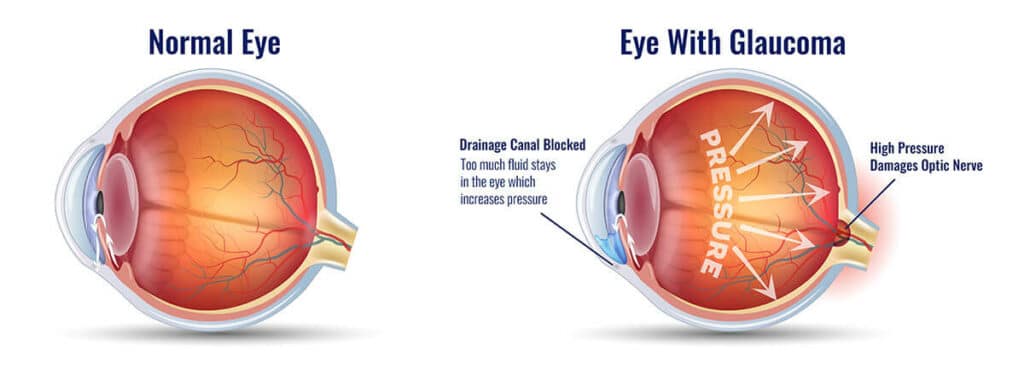

Glaucoma is often called the “silent thief of sight” because it’s a slowly progressive eye disease that leads to blindness. In early stages, glaucoma symptoms may go unnoticed. Glaucoma usually does not cause pain, so you may not know you have the condition. If left untreated, glaucoma causes permanent damage to the optic nerve, leading to blindness and decrease of quality of life. However, early detection and treatment of the disease can halt further progression.
The doctors at Premier Eye Clinic located in Port Orange and Ormond Beach offer annual eye examinations for those over the age of 40 to monitor eye diseases, in order to receive proper treatment and vision loss can be avoided. Dr. Aliancy is a glaucoma specialist with expertise in the medical and surgical management of glaucoma serving the patients of Volusia county and surrounding areas.
The cause of glaucoma is unknown, but there are several risk factors that increase your risk of developing glaucoma. These include high eye pressure (called intraocular pressure, or IOP), older age, being African-American or Hispanic, and having a family history of glaucoma. Anyone with any of these risk factors should have regular eye exams.
Glaucoma damages vision by destroying the optic nerve, which connects your eye to your brain, and carries visual information to your brain for processing. When the optic nerve is damaged from glaucoma, you lose your vision. Your peripheral vision—or side vision—is lost first. If the glaucoma remains untreated, the vision loss creeps in toward the center, first causing tunnel vision, and then, eventually, blindness.
Glaucoma represents a specific spectrum of optic neuropathies with characteristic structural and functional changes of the optic nerve, with primary open angle glaucoma representing the majority of cases. The cause of primary open angle glaucoma is unknown, but there are several risk factors that increase your risk of developing glaucoma. These include family history, high eye pressure (called intraocular pressure, or IOP), older age, and ocular biometrics (such as thin corneas). Anyone with any of these risk factors should be screened for glaucoma. There are other forms of glaucoma, for example, uveitic glaucoma, chronic angle closure glaucoma and normal tension glaucoma. All forms of glaucoma require a comprehensive evaluation and accurate diagnosis to provide the appropriate treatment plan.

If you are diagnosed with glaucoma, treatment is available to save your vision. The goal of glaucoma treatment is to lower IOP and stop the optic nerve damage. Several treatments are available to lower IOP. These include eye drops, laser therapy, and surgery.
A comprehensive screening evaluation for glaucoma should include the measurement of IOP, corneal biometrics, color vision testing, optic nerve bio-microscopy, and assessing the structure and function your optic nerves. Visual field testing is the main modality to assess the function of your optic nerves. Visual field testing will test your peripheral and central vision and helps establish the diagnosis of glaucoma and monitor the progression of disease. Optical coherence tomography (OCT) allows for structural analysis of your optic nerve and is complimentary to visual field testing. The results of the screening evaluation helps determine the treatment regimen.
Premier Eye Clinic provides both diagnostic and treatment options for glaucoma. If you live in Volusia county or the surrounding areas and are seeking a second opinion regarding your specific case of glaucoma, we are happy to arrange a time to evaluate you. Treatment options for glaucoma are continuing to change. Please feel free to read about some of the treatment options that we provide in our office below.
Intraocular pressure reduction remains the main modality of glaucoma treatment. Intraocular pressure reduction can be achieved with topical medications, laser treatment and surgery.
A wide range of topical drops are currently available for the treatment of glaucoma. A complete medical history and ocular examination can help determine which class of glaucoma medications are based.
Selective Laser Trabeculoplasty (SLT) is becoming a widely accepted first-line glaucoma treatment option. Ophthalmologists can now lower eye pressure by using SLT, thus possibly avoiding invasive incisional surgery in the future. Laser treatment is applied to tissue involved in the drainage system of your eye, which leads to an extracellular remodeling process that promotes augmentation of aqueous drainage. SLT treatment takes only a few minutes, performed in the office (not the operating room), safe and effectively lowers eye pressure in most people. This treatment is approved by the Food and Drug Administration (FDA) for treating glaucoma and is covered by essentially all insurance plans.
Glaucoma surgical options attempt to either improve aqueous drainage via altering the original drainage anatomy or creating a new drainage pathway. Options begin with minimally invasive surgeries such as goniotomy, canaloplasty and micro-shunt insertion that can be combined with cataract surgery. Incisional glaucoma surgeries are more involving and aim to establish a new drainage pathway. Advanced glaucoma surgeries included glaucoma drainage device placement and trabeculectomy. It is important to assess the severity of glaucoma damage to the optic nerve to find the appropriate treatment plan.